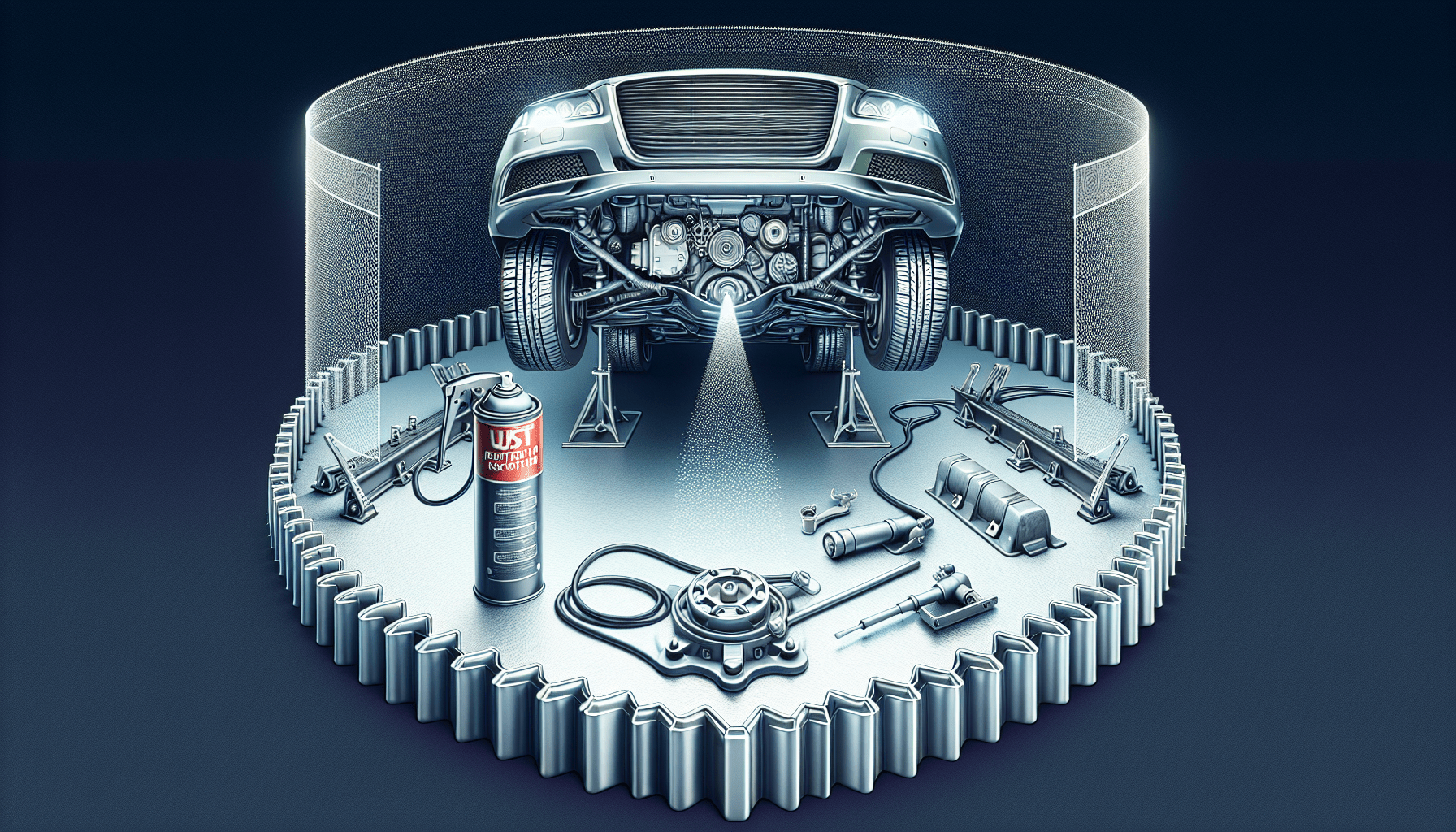Ace Mobile
Detailing

Top 4 Tips For Protecting Your Car’s Undercarriage
Are you a car owner looking to protect your vehicle’s undercarriage? Look no further! In this article, we will share with you the top 4 tips for keeping your car’s undercarriage in pristine condition. From regular cleaning to rust prevention, we’ve got you covered. With our expert advice, you can ensure that your car’s undercarriage remains protected, allowing you to drive with peace of mind. Say goodbye to worrying about damage caused by road salt, debris, and other environmental factors. Let’s get started on protecting your car’s undercarriage today!

Regularly Clean Your Undercarriage
Having a clean undercarriage not only improves the appearance of your vehicle, but it also helps to prevent the buildup of dirt and grime that can lead to corrosion and damage. One of the most effective ways to clean your undercarriage is by using a pressure washer. This powerful tool can easily remove stubborn dirt and debris that may be lodged in hard-to-reach areas. Make sure to use a nozzle with a wide-angle spray to cover a larger area and thoroughly clean the undercarriage.
In addition to using a pressure washer, it is often necessary to use a degreaser to remove stubborn dirt and grime that may be stuck to your undercarriage. Apply the degreaser to the affected areas and let it sit for a few minutes to allow it to penetrate and break down the dirt. Then, scrub the area with a brush to help loosen the dirt and grime. Rinse off the degreaser with a pressure washer or hose, making sure to thoroughly clean the entire undercarriage.
After cleaning, take the time to inspect your undercarriage for any signs of damage or corrosion. Look for rust spots, dents, or any other imperfections that may require attention. If you notice any issues, it is important to address them as soon as possible to prevent further damage. Regularly cleaning and inspecting your undercarriage will help to prolong its lifespan and keep it looking great.
Apply a Protective Coating
Once your undercarriage is clean, it is important to apply a protective coating to help prevent damage from dirt, debris, and road salt. One option is to use an undercarriage sealer, which creates a barrier between your vehicle’s undercarriage and the outside elements. Apply the sealer according to the manufacturer’s instructions, making sure to cover all exposed metal surfaces.
Another option for protecting your undercarriage is to apply a rustproofing solution. This solution helps to inhibit the formation of rust by preventing moisture from reaching the metal surfaces. Apply the rustproofing solution to the undercarriage, paying close attention to any areas that are prone to rusting, such as the wheel wells and frame.
Additionally, you may want to consider using an anti-corrosion wax on your undercarriage. This wax creates a protective barrier that helps to repel water and prevent corrosion. Apply the wax according to the manufacturer’s instructions, making sure to cover all exposed metal surfaces.
By applying a protective coating to your undercarriage, you can help to prolong its lifespan and protect it from the harsh elements it may encounter on the road.
Avoid Driving on Rough Terrain
One of the best ways to protect your undercarriage is by avoiding driving on rough terrain whenever possible. Off-roading, in particular, can be extremely damaging to your vehicle’s undercarriage, as it exposes it to rocks, uneven surfaces, and other hazards. If you do need to drive on unpaved roads, be cautious and drive slowly to minimize the risk of damage.
Another potential hazard to watch out for is potholes and speed bumps. These can cause significant damage to your undercarriage if you hit them at high speeds. Always be mindful of the road conditions and take extra care when driving over bumps or holes in the road.
By avoiding rough terrain and being cautious of potential hazards, you can help to keep your undercarriage in good condition and prevent unnecessary damage.
Install Undercarriage Protection
To provide an extra layer of protection for your undercarriage, consider installing undercarriage protection. One option is to add a skid plate, which is a metal plate that attaches to the underside of your vehicle. Skid plates provide additional protection for the vulnerable parts of your undercarriage, such as the oil pan, transmission, and differential.
Another option for undercarriage protection is to install stone guards or mud flaps. These accessories help to prevent rocks, debris, and mud from being thrown up into the undercarriage, reducing the risk of damage. They can be easily installed and are available for a wide variety of vehicles.
Additionally, you may want to consider undercoating your vehicle. Undercoating is a chemical coating that is applied to the undercarriage, providing an extra layer of protection against rust and corrosion. It helps to seal any gaps or imperfections in the metal, preventing moisture from reaching the surfaces.
By installing undercarriage protection, you can help to prevent damage to your undercarriage and prolong its lifespan.

Regularly Inspect and Maintain Your Undercarriage
Regularly inspecting and maintaining your undercarriage is crucial for its longevity and overall performance. Start by checking for loose or damaged parts, such as loose bolts or hanging exhaust components. If you notice anything out of the ordinary, it is important to have it repaired or replaced as soon as possible to prevent further damage.
In addition, monitor your undercarriage for any signs of leaks. Leaking fluids, such as oil, coolant, or transmission fluid, can indicate a problem that needs to be addressed. If you notice any leaks, have them inspected and repaired by a professional mechanic.
Another important aspect of maintaining your undercarriage is scheduling regular maintenance. This includes oil changes, inspections, and any other recommended services for your specific vehicle. Following the manufacturer’s recommended maintenance schedule will help to keep your undercarriage in optimal condition and prevent potential issues.
If you are unsure about inspecting or maintaining your undercarriage, it is always a good idea to consult a professional mechanic. They have the knowledge and expertise to properly assess and address any issues with your undercarriage, ensuring that it is well-maintained and protected.
By regularly inspecting and maintaining your undercarriage, you can help to prolong its lifespan and ensure that your vehicle operates at its best.

